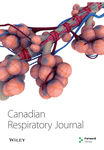Comparison of Per Cent Predicted and Percentile Values for Pulmonary Function Test Interpretation
Abstract
BACKGROUND: Pulmonary function tests (PFTs) are commonly interpreted as a fraction of predicted normal values, with an abnormal test often defined as less than 80% or greater than 120% of the predicted value. However, recommendations of the American Thoracic Society/European Respiratory Society suggest using a percentile-based approach to define an abnormal test (less than the fifth or greater than the 95th percentiles).
OBJECTIVE: To compare PFT values obtained by the per cent predicted method with the percentile-based method for lung function parameters.
METHODS: Full PFTs performed between January 2000 and July 2004, at the Health Sciences Centre (Winnipeg, Manitoba) were analyzed. Using the Crapo and Gutierrez equations, per cent predicted and percentile values were calculated. An abnormal test was defined as less than 80% or greater than 120% of predicted (per cent predicted method) or as less than the fifth or greater than the 95th percentiles (percentile method). Using the percentile method as reference standard, the diagnostic test characteristics of the per cent predicted method were calculated.
RESULTS: The full PFTs of 2176 men and 1658 women were analyzed using the Crapo and Gutierrez equations. The mean (± SD) age of all subjects was 52±15 years. Per cent agreement between the two tests was more than 94% for all parameters except for reduced residual volume (88%). Per cent predicted methods had suboptimal sensitivity for abnormal total lung capacity (88% to 89%), increased residual volume (83% to 89%) and reduced diffusion capacity (89% with Crapo equations). Suboptimal specificity (83% to 86%) was observed for decreased residual volume.
CONCLUSION: The results of the per cent predicted and percentile-based approaches for PFT interpretation were similar for the majority of lung function parameters. These two methods can be used interchangeably for spirometry. However, caution may be warranted in relying solely on per cent predicted methods for assessing lung volume or diffusion capacity.




